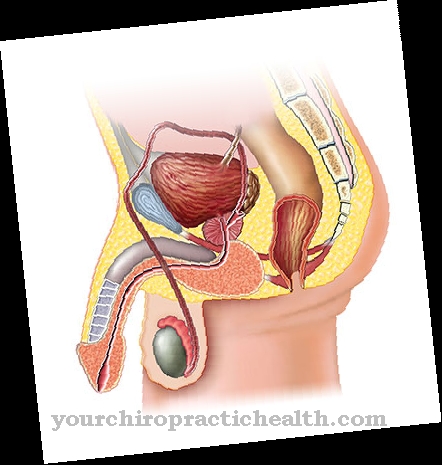epilepsy or recurring epileptic seizures are a neurological disease of the brain. The convulsive and twitching seizures in particular are a clear sign of epilepsy.
What is epilepsy

Epilepsy is a neurological and chronic disease that can lead to the typical epileptic seizures. These attacks are usually accompanied by cramps. Epilepsy occurs when such seizures occur regularly.
From a biological point of view, epileptic seizures are acute functional disorders in the area of the central nervous system in the brain. The seizures usually last up to two minutes. In epilepsy, there are also tremors or twitches and disorders of consciousness and memory lapses. In Germany, around one percent of the population (especially children and adolescents) suffer from epilepsy or epileptic seizures.
causes
The causes of epilepsy can be very different. Most often, however, depolarizations, i.e. pathological discharges, apply in the nerve cells of the brain, which can lead to a high level of excitability.
Further causes are hyperventilation, lack of sleep, psychological and emotional stress, drug consumption (including alcohol) and a lack of oxygen.
Epilepsy can be hereditary or familial. Especially if the direct ancestors had predispositions to metabolic disorders, brain diseases and psychosomatic diseases. Epilepsy itself can be divided into idiopathic and symptomatic epilepsy.
Symptoms, ailments and signs
The symptoms of epilepsy can vary widely. So it does not come with twitches and cramps in every person affected. In addition, a distinction must be made between focal and generalized epileptic seizures. Typical signs of an epilepsy attack are open, empty, twisted, or rigid eyes.
The seizure takes a maximum of two minutes. Often times it only lasts a few seconds and is only noticeable as a dropout. In some epileptics, the symptoms also turn out to be twitching of the limbs or extensive disorders of consciousness or movement. If a so-called grand mal seizure occurs, which is accompanied by rhythmic jerks and cramps, muscle soreness often occurs in the following days.
A distinction must also be made between a focal and a generalized epilepsy attack. A partial seizure originates in a specific region of the brain. The type of complaints depends on this region. If the attack occurs on the right side of the brain, it causes twitching on the left side of the body. In contrast, a seizure that originates in the left hemisphere affects the limbs on the right side of the body. Some epileptics also perceive colors or flashes of light.
In addition, there is a risk of symptoms such as pressure in the abdomen, racing heart, dizziness, anxiety and the perception of voices or sounds. A generalized epilepsy attack is when it comes from the entire brain. This leads to pronounced clouding of consciousness, which can extend to severe unconsciousness.
course
Epilepsy is a chronic disease. This means that the disease is recurring and the seizures or epileptic seizures can occur again and again.
If epilepsy is treated, the prognosis for recovery is quite favorable. However, holistic healing cannot be spoken of as long as the person concerned is advised on drugs for epilepsy.
However, if the treatment is successful, the chance of a life without epileptic seizures is around 60 to 80 percent. Complications usually only occur when generalized seizures occur.
In this form of epilepsy (status epilepticus), those affected do not regain consciousness between the seizures. This can then lead to a life-threatening course.
Complications
Well-adjusted patients have to undergo regular check-ups despite having no symptoms. Because even if medication is taken, epilepsy can recur. The specialist uses blood tests to determine whether the medication is sufficient or whether it can even be reduced.
Control is important even after an operation. If the seizures were triggered by a tumor or a blood clot in the head, new events can occur despite removing the cause. Shortly after an operation, the controls are within a tight timeframe. After a while, the distance can be increased.
Untreated epilepsy regularly leads to the death of brain cells. This applies to both BMS cramps in infancy and grand mal seizures in adolescents and adults. Healthy brain cells can take over the activity of the affected cells to a certain extent. The phrase "to a certain extent" is to be taken literally because, unlike other body cells, the cells of the brain cannot be repaired or replaced.
Another danger of untreated epilepsy is that the seizures increase and not only endanger those affected. Drivers who suffer from it are a risk to other road users. If an accident is based on an epileptic seizure, the person concerned must expect high fines.
When should you go to the doctor?
In the event of an epileptic seizure, a doctor should always be consulted. The cause of the seizure should be examined medically, even if it lasts only a few minutes or several years have passed between the onset of the seizure disorder. With every seizure, there is a risk of brain damage or the seizure leading to further functional disorders. These must be diagnosed and then treated so as not to cause permanent consequences.
After a comprehensive examination, a decision is made individually whether further therapy should be carried out. Therapy is recommended at the latest after suffering several epileptic seizures. If there are signs of inflammation or a metabolic disease, medical care is necessary. In some patients, a surgical procedure is carried out, which can lead to permanent freedom from symptoms.
Since each seizure can have a different cause, it is necessary to be re-examined if you have another seizure. It is helpful if an observer of the epileptic seizure is present when you visit a doctor. This can give important information about the progression of the convulsive disorder, which contribute to the diagnosis. If the patient decides on drug treatment, he should consult a doctor as soon as unusual side effects set in or if there are intolerances.
Doctors & therapists in your area
Treatment & Therapy
The therapy or treatment of epilepsy should definitely be carried out by a specialist. It is important to bring witnesses of an epileptic seizure with you in order to better describe the exact symptoms. Thereafter, the patient's brain is usually examined with magnetic resonance imaging (MRI). Above all, structural disturbances and anomalies are to be identified. Then unusual neuronal discharges can be diagnosed with the help of electroencephalography (EEG).
Immediate measures in the event of a sudden epileptic seizure are primarily to prevent injuries from falls. Likewise, dangerous and pointed objects should be avoided in a household in which an epileptic lives. A soft floor is also beneficial. In addition, family members or other accompanying persons should precisely document the seizure. This will help the doctor later with individual treatment. If the acute attack lasts longer than two minutes, the emergency doctor or urgent medical help must be called.
Outlook & forecast
Epilepsy has very individual prognoses. There are people who have an epileptic seizure once in their life and are then completely free of symptoms. There are no consequential damages or other health impairments.
These patients have a good prognosis, although initially they do not know that they belong to this group of patients. If no more seizures occur within 3-4 years, doctors speak of recovery. No abnormalities can be detected in the EEG. Thus epilepsy is considered cured.
An underlying disease can be diagnosed in a large number of patients. Their prognosis depends on the disease and can be very different. If the present disease is cured, the epilepsy also disappears. However, if the epilepsy cannot be cured, drug treatment can in most cases relieve the symptoms. About 90% of patients become seizure-free with the medication and can experience a good quality of life despite epilepsy.
This is especially true in patients who are affected by brief seizures with mild disturbances of consciousness. 50-80% of patients who suffer particularly severe seizures experience a significant improvement in symptoms within a year with therapy. Nevertheless, there is the possibility of lifelong severe impairments and severe consequential damage due to epilepsy.
Aftercare
Since epilepsy is incurable, regular and comprehensive follow-up care is required. Epilepsy, which has its cause in the brain, can change constantly as the disease progresses. For this reason, an EEG should be made regularly, possibly even an imaging of the head, such as in an MRI, is necessary to identify the cause and, if necessary, to readjust it.
The doctor should also puncture the liquor, i.e. the nerve fluid, since the cause can also be found in this way. The patient should see a doctor regularly to check the medication setting and possible side effects and, if necessary, make a change. If drug therapy and its conversion fail, surgical therapy can be an alternative option.
The patient should be informed about this possibility and, if consented, be prepared accordingly. Psychological support for the patient can also be useful in order to identify and prevent psychological complications. Antidepressants may then be necessary, as depression is a common secondary disease.
Psychological support for relatives can also be recommended. In addition, relatives should be trained to recognize an epileptic seizure and take appropriate action. In the event of a cramp, the emergency doctor should be called immediately, as this can be life-threatening.
You can do that yourself
For epileptics, there are several ways to reduce the chances of having a seizure without solely taking medication.
For example, it has been shown that a ketogenic diet (high in fat, hardly any carbohydrates, moderate protein content) lowers the risk of seizures in around two thirds of those affected. Why this is so is unclear. This diet is effective after a few weeks and should be carried out for several years. It brings - especially at the beginning - a few side effects and can have a long-term stressful effect on the cardiovascular system.
As part of a so-called biofeedback therapy and in the course of behavioral therapy measures, it is possible for those affected to gain increased control over the triggering brain areas. In many cases, it is possible to counteract an overdrive of the corresponding area caused by stimuli.
Transcutaneous vagus nerve stimulation is non-invasive and does not require a hospital stay. It consists in the fact that the vagus nerve is stimulated in a targeted manner by means of a pulse generator attached to the ear, the intensity and frequency of which must be set by the person concerned. The excitement from a mild tingling sensation is directed into the brain and reduces the likelihood of seizures.
Carrying an epilepsy dog with you brings security because it represents an early warning system. These dogs can usually be trained to warn the epileptic to remove dangerous objects from his environment and to draw attention to him (for help in the event of an attack) .





.jpg)






.jpg)



.jpg)










.jpg)
